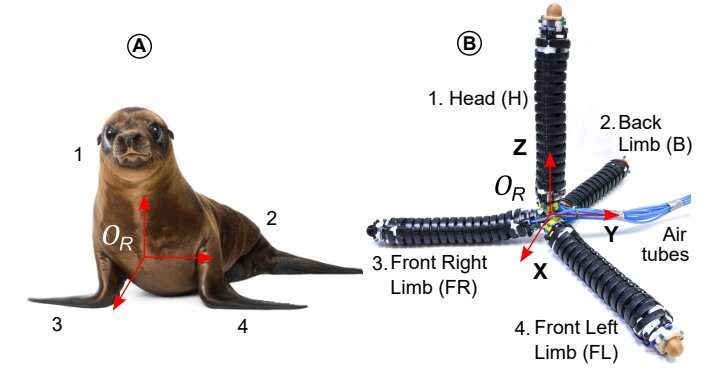
Recent progress in robotics has brought us startlingly lifelike replicas of humans and animals.
An $8 million Russian robot named Alex capable of 600 human facial expressions and speech has been called the most realistic robot in the world. Sparky, the creation of Chinese startup Hengbot, is the first robotic dog with musculoskeletal limbs; it can run, jump and do natural-looking dog tricks. And Scorpio Hexapod, from Belgium’s Ghent University, can crawl in all directions while providing creepy realism—though without the sting.
But sometimes, in order for science to move forward, it must take a step backward. In this case, some wobbly steps backward.
Researchers at DePaul University in Chicago studied the seemingly clumsy, graceless bobbing of pinnipeds to recreate the motions for robotic creatures they say may one day assist in rescue operations.
Pinnipeds—the technical name for fin-footed mammals such as seals, sea lions and walruses—drew the interest of Dimuthu Kodippili Arachchige and his colleagues for their potential to offer types of mobility that are not possible with current “soft-limbed” robotic efforts.
They point to robot prototypes that provided crawling and undulating motions but were otherwise restricted to straight movement, unable to turn. Another approach that addressed the mobility issue still was hobbled by limited gait diversity. And while a starfish-inspired effort incorporating limbs with variable stiffness offered further mobility improvements, they were hampered by slow speed.
Arachchige said, “We aimed to create a robot that has improved degrees of freedom, gait trajectory diversity, limb dexterity and payload capabilities.”
The soft-limbed pinniped robot addresses the limitations of those earlier efforts, he said.
Each robot limb, about 9.5 inches long by 1.5 inches wide, is driven by three pneumatic muscle actuators. The limbs can be filled with liquid that makes them stiff; when drained, the limbs become more flexible. The robotic seal changes direction based on the changing states of the limbs. The device is supported by a protective outer shell and backbone.
The robotic seal’s utility stems from its ability to bounce and lunge over uneven terrain that can be problematic for robots replicating the movements of four-legged creatures such as dogs.
Ironically, the robotic seal moves faster bobbing backwards than it does going forward. It can move at a swift 6.5 inches per second in reverse, but slows to 4.5 inches per second going forward.
“Most of a seal’s weight is concentrated towards the rear of their body, but due to the even distribution of weight in the robot, it becomes challenging to stay upright while moving forward,” Arachchige said. “On the contrary, when it’s moving backward, the robot’s body helps maintain the balance by countering torque produced by its movement.”
Soft mobile robots are better able to absorb ground impact forces and maneuver through confined and irregularly shaped areas.
As for the future of robotic seals, Arachchige said, “Soft mobile robots have great potential to replace humans in performing dangerous tasks such as nuclear site inspection, search and rescue operations, and planetary exploration.”
The group’s paper has been accepted to the 2023 IEEE/ASME International Conference on Advanced Intelligent Mechatronics (AIM) and is currently published on the arXiv preprint server.
More information:
Dimuthu D. K. Arachchige et al, Study on Soft Robotic Pinniped Locomotion, arXiv (2023). DOI: 10.48550/arxiv.2304.06945
© 2023 Science X Network
Citation:
Robotic seal’s gait may be graceless, but it could help save lives (2023, April 28)
retrieved 28 April 2023
from https://techxplore.com/news/2023-04-robotic-gait-graceless.html
This document is subject to copyright. Apart from any fair dealing for the purpose of private study or research, no
part may be reproduced without the written permission. The content is provided for information purposes only.
Stay connected with us on social media platform for instant update click here to join our Twitter, & Facebook
We are now on Telegram. Click here to join our channel (@TechiUpdate) and stay updated with the latest Technology headlines.
For all the latest Technology News Click Here
For the latest news and updates, follow us on Google News.
